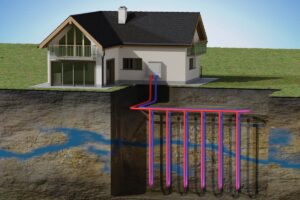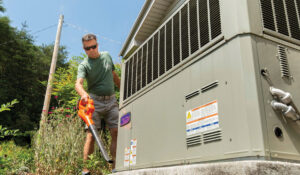Dear Pat and Brad: My neighbor claims they were able to cut their energy bills nearly in half. Is that even possible? What would I have to do to get there? It sounds like it would take a lot of time and money. – Luke
Dear Luke: The story you heard is not far-fetched. We’ve been involved with energy efficiency programs that have achieved those kinds of results. Let’s talk about some energy-saving measures you can do right away and how to plan for greater savings down the road.
Dial in savings
Now: The first place to start is your home thermostat. In most homes, the largest portion of the energy bill goes toward heating and cooling. Setting back your thermostat by 7 to 10 degrees for eight hours a day can save you up to 10 percent a year on heating and cooling. In the winter, you could aim for 56 F at night and when no one is at home, and 68 F when you’re up and around. If you’re used to a warmer house, it may mean throwing on a sweater or pair of slippers. It should be noted this tactic is not as effective for some homes with radiant heat systems.
Later: Make sure to adjust your air conditioning settings next summer. If you have a manual thermostat and don’t always remember to adjust it, consider purchasing a smart thermostat, or at least one that’s programmable.
Set refrigerator and freezer temps for efficiency
Now: Make sure your refrigerator and freezer aren’t set to a colder temperature than needed. The fridge should be at 38 F to 40 F and the freezer compartment should be 5 F. If you have a separate chest freezer, set it to 0 F. Also check your water heater setting. You should aim for a setting of 120 F.
Later: Old refrigerators and freezers can use a lot of electricity. If yours was made before 1993, you can save upwards of $65 a year with a new ENERGY STAR® model. If you eliminate a second refrigerator or freezer, you can save even more, especially if they are stored in your garage.
Maximize the heat you’ve got
Now: Look around each room and make sure the vents and radiators aren’t blocked by furniture or other objects. If the floors feel cold even when the room is warm, put down area rugs for additional warmth. Open curtains and blinds to let the sunshine in, and close them at night.
Later: Enlist the help of an energy auditor or HVAC specialist to test for duct leakage and ensure your whole system is balanced and running efficiently.
Make bright moves with your lights
Now: The obvious first step is to make sure lights are turned off when they’re not in use. You can do this manually or employ one of many automated strategies. If you’re still using incandescent bulbs, you could switch the five most-used bulbs to LEDs and save about $75 per year. LEDs last much longer and use about one-fourth as much energy. Prices on LED bulbs have decreased in the past few years, and you can save more if you buy them in packs.
Later: Over time, plan to replace all your old incandescent bulbs, and consider smart lighting options that can be programmed to turn off when a room is not in use.
Eliminate drafts
Now: Look carefully around your home for signs of air leaks. If you have a gap under an exterior door, you can block it with a towel or better yet, install some weather stripping. Make sure windows are sealed with caulk, and you can also seal areas around plumbing and wiring penetrations.
Later: Have an energy auditor do a blower door test, which is the best way to identify all air leaks.
Taking some of these easy steps now should provide some quick energy savings. To save even more, you’ll need a plan that includes the “later” steps we’ve shared above. An energy audit can help you determine a much better plan, and your electric co-op may be able to provide an audit or recommend a qualified local auditor.









